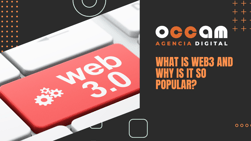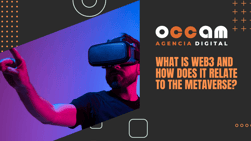Index Content
When we talk about new technologies, we know that we are dealing with a changing subject. The Internet world is facing constant modifications and evolutions. The web is not going to be left behind. Currently, we are talking about Web.3.0, but what is the meaning of the web, what are the differences between Web 2.0 and 3.0?
what is the web?
A web page is the document that forms part of a website, can integrate text, sound, video, programmes, links, images, hyperlinks and other elements, adapted for the World Wide Web (WWW), and can be accessed and viewed using a web browser - which interprets the language in which the web page is developed, such as HTML. To be a web page, it shares these characteristics: it contains textual information and audiovisual material, has an attractive design, is optimised and acts as a business card for a company, a person or a specific professional.
The first websites were very simple static pages. Their modification was only possible from the html code. The designers of the first websites did not pay attention to accessibility - logically, taking into account the lack of technology and tools that would facilitate better development. It is known as Web 1.0 or read-only, as there was no possibility of interaction between websites and users. This first version of the Internet was in force between the 1990s and 2004.
With globalisation and the speed at which new technologies have advanced, millions of people are connected to the Internet. Today, we have changed all the activities of our routine, to integrate the Internet. It is a strong and stable infrastructure, with which millions of companies work with it, on or through it.
This great change was achieved with the Web 2.0 model. We refer to this web version as the result of the Internet we know today. It is a web that allows writing, as well as reading. Within Web 2.0, there are platforms where users can create content, which is why we know it as the Social Web. With it, social networks also appear. It allows centralised connection, so users begin to participate in forums, blogs...
We know these websites, because they are the ones we use - clearly, from 2004 to the present day there have been changes and improvements. Technologies have allowed interactive platforms to be designed, or new services such as audio and video streaming.
So if we have already advanced to this point, what can Web 3.0 offer us? Web 3.0 wants to change everything we know, from interactions to how websites are published. This idea is driven by the desire to democratise the Internet. Until now, the Internet has been dominated by companies and businesses that exchange personal data for services, but due to the controversy, controversies and problems that some companies have had on the media agenda, there is a sector of the population that wants to push for change on the Internet.
One of these steps is Web 3.0 or decentralised applications that run on the blockchain, i.e. that allow users to interact and participate without having to share their personal data. By decentralisation, we mean that no single entity has control over the entire processing of the blockchain. However, it should be stressed that blockchains are politically decentralised - since nobody controls them - and architecturally decentralised - since there is no central point of infrastructure failure - but they are logically centralised, because there is a commonly agreed state and the system behaves like a single computer. It is distributed between builders and users.
In this way, we know Web 3.0 as the web of ownership. Users are given ownership of their digital assets. Ownership is achieved through tokens, i.e. encrypted information that is grouped into blocks. This information, or message, can represent any kind of good, action or service. Tokens or non-fungible tokens (NFT) give power to content creators.
Differences between Web 2.0 and Web 3.0
|
Web 2.0 |
Web 3.0 |
|
Censorship exists, if the social network provider or server wants to censor some content. |
There would be no censorship because the control is decentralised. |
|
There is the possibility of limiting payments for certain types of work, as decided by the payment services themselves. |
Payments cannot be blocked, as they do not require personal data. |
|
Servers of gig-economy apps could crash, and affect the worker's income. |
Servers cannot crash, they use Ethereum, a decentralised network of thousands of computers as a backend. |
Advantages of Web 3.0
- No permissions required to access the service, which benefits user participation because no one can deny or block access.
- Payments are incorporated through the native token. To read more about the security of blockchain payments, read our blog article.
- It offers reliability, it gives users more freedom and creators more control over their own data, and they benefit from it, because they monetise their content directly, without intermediaries.
- It opens up control of the ownership of the web, there is no longer an entity that controls, censors or restricts, they try to create the democracy of the Internet.
- Data becomes completely public, any user can have access to it, transparency is achieved.
- The aim is to try to ensure that the browsing experience is more in line with the user's preferences.
- It offers the possibility to increase the sales rate, you can better identify sales needs with the help of artificial intelligence, which will only show ads for products that customers want.
- It has the ability to provide service at any time because the server has a higher level of availability than before.
- Increased resilience and security against hacking and denial of service attacks.
- Since no real identity is required, it is possible to remain anonymous.
- Data stored on the blockchain is immutable.
- The service is not interrupted for technical reasons due to re-decentralisation.
Therefore, although Web 2.0 offers platforms where content is created and user participation is achieved, there is a growing number of users who need the advantages offered by Web 3.0 such as gaining ownership of content and ending the monopoly of entities that do not allow the democratisation of the Internet.





